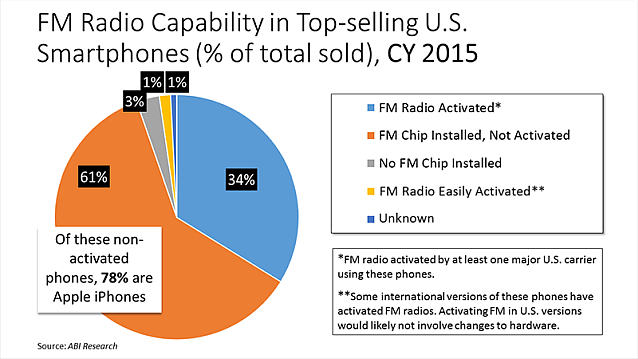The National Association of Broadcasters’ (NAB’s) Pilot research division has complete a survey of FM capability in U.S. smartphones sold in 2015. While FM reception continues to advance in the U.S. smartphone footprint, it remains mostly absent, and one unfortunate fact is likely to keep it that way.
There are two essential considerations to keep in mind with smartphone FM reception. First is the presence of an FM chip (like a miniature radio) in the phone. Nearly all phones have those chips. The second is whether that chip is “activated” (whether the miniature radio is plugged in). Most are not, and that’s what Pilot investigated. The activation of FM chips, and the use of over-the-air radio on smartphones, is also the mission of Emmis-owned NextRadio.

Pilot reports that 34% of U.S. smartphones sold in 2015 have activated FM chips. That means the internal radios are plugged in, so to speak, but not necessarily turned on (i.e. used by their owners). A larger 61% of sold phone have UNactivated FM chips, and cannot receive over-the-air FM. So, more or less 2-to-1 unactivated chips.
Here’s the really bad news for FM-via-phone advocates: 78% of that 61% (unactivated phones) belongs to Apple phones. Why so bad? Because Apple is unlikely to activate iPhone FM chips.
At RAIN News we have long believed that Apple is responsible for killing user expectation of tuning FM on mobile devices. Before Apple introduced the iPod, FM reception was a standard feature on existing MP3 players. The RAIN gadget museum has several early MP3 players that were gladly used for radio in addition to downloaded music. The iPod (and later the iPhone) shut down FM reception — understandably, as Apple would not want radio to compete with the iTunes/iPod synergy which drove iTunes Music Store success.
We’d like to see OTA radio become standard in smartphones, but realistically aren’t holding our breath. In the meantime, dropping data charges and no-data listening plans offered by some carriers make it increasingly simple to listen via Internet delivery.
